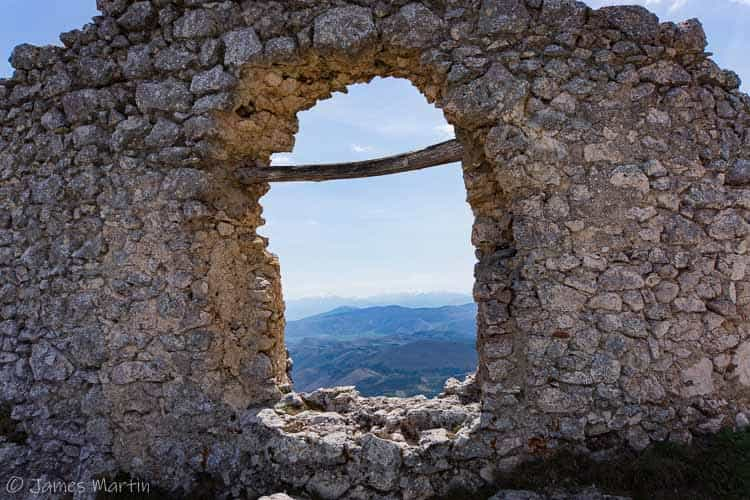
At 1,500 meter above sea level, the Castle of Rocca Calascio is the highest castle in the Apennines. The ruins seem to grow out of the rocky rise upon which the castle sits.
The fortress attracts 100,000 tourists a year.
The fortress and its position was all about the sheep and the wool trade. From Rocca Calascio one can peer down at the routes, the roads and game trails that pass near the Abruzzo’s highest peak, the Gran Sasso. Destroyed in an earthquake in 1703, the castle has turned into an evocative set of ruins to visit, it’s window openings still framing the fantastic views of the countryside.


The group of medieval houses that clung to the castle for safety were destroyed as well, sending folks to the town of Calascio to the southeast.

When we visited in April, trees all over this corner of the Abruzzo were in bloom and there wasn’t a single tourist to be seen at the ruins.
Near the castle, there is a church, the church of Santa Maria della Pietà.


Where to eat & Stay
We had a fine meal at Bar Ristorante Rifugio della Rocca, between the Rocca and the town of Calascio. There are also restaurants in Calascio you can try. The Rifugio is also a place you can stay.
In a place that pioneered the concept of “albergo diffuso”, Sextantio Albergo Diffuso in Santo Stefano di Sessanio is just a short drive away. An airport shuttle is available if you don’t have a car, and the Sextantio has a solid 9.4 rating from folks who have stayed there.
What’s Ahead for Calascio?
Big changes could be underway for Calascio.
The tiny village of 130 people, of which only 70 spend the winters in the harsh environment, has won 20 million euros in funds they hope will bring Calascio back to life.
Local officials have put restoring the ruins and attracting tourists at the heart of their bid to revive the village, which has won 20 million euros ($22 million) in EU post-pandemic funds. — How one dying Italian village plans to spend €20m in EU recovery funds
A museum is planned, and the area hopes to increase production of its unique cheese, “Marcetto, a traditional sheep’s cheese made using live maggots, which soften it with their digestive acids”
I’m looking forward to seeing this all pan out. And the cheese! Who wouldn’t want to taste that?
For an itinerary that includes the castle, see Martha’s Italy: Abruzzo Villages Road Trip.